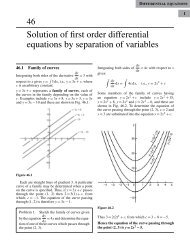integration
Create successful ePaper yourself
Turn your PDF publications into a flip-book with our unique Google optimized e-Paper software.
378 INTEGRAL CALCULUS<br />
At the points of intersection the co-ordinates of the<br />
curves are equal. Since y = x 2 then y 2 = x 4 . Hence<br />
equating the y 2 values at the points of intersection:<br />
x 4 = 8x<br />
from which, x 4 − 8x = 0<br />
and x(x 3 − 8) = 0<br />
Hence, at the points of intersection, x = 0 and x = 2.<br />
When x = 0, y = 0 and when x = 2, y = 4. The<br />
points of intersection of the curves y = x 2 and<br />
y 2 = 8x are therefore at (0,0) and (2,4). A sketch is<br />
shown in Fig. 38.8. If y 2 = 8x then y = √ 8x.<br />
Shaded area<br />
=<br />
∫ 2<br />
0<br />
⎡<br />
= ⎣ ( 3<br />
√ ) x 2<br />
8<br />
(√<br />
8x − x<br />
2 ) dx =<br />
3<br />
2<br />
⎤<br />
− x3 ⎦<br />
3<br />
2<br />
0<br />
∫ 2<br />
0<br />
(√<br />
8<br />
)<br />
x 1 2 − x 2 )<br />
dx<br />
{√ √ }<br />
8 8<br />
= − 8 −{0}<br />
3<br />
3<br />
2<br />
= 16 3 − 8 3 = 8 3 = 22 square units<br />
3<br />
Figure 38.8<br />
The volume produced by revolving the shaded area<br />
about the x-axis is given by:<br />
{(volume produced by revolving y 2 = 8x)<br />
− (volume produced by revolving y = x 2 )}<br />
i.e. volume =<br />
= π<br />
∫ 2<br />
0<br />
∫ 2<br />
0<br />
π(8x)dx −<br />
∫ 2<br />
0<br />
(8x − x 4 )dx = π<br />
π(x 4 )dx<br />
[(<br />
= π 16 − 32 ) ]<br />
− (0)<br />
5<br />
= 9.6π cubic units<br />
Now try the following exercise.<br />
Exercise 150<br />
[<br />
8x 2<br />
2 − x5<br />
5<br />
Further problems on volumes<br />
1. The curve xy = 3 is revolved one revolution<br />
about the x-axis between the limits x = 2 and<br />
x = 3. Determine the volume of the solid<br />
produced.<br />
[1.5π cubic units]<br />
2. The area between y<br />
x 2 = 1 and y + x2 = 8is<br />
rotated 360 ◦ about the x-axis. Find the volume<br />
produced. [170 2 3π cubic units]<br />
3. The curve y = 2x 2 +3 is rotated about (a) the<br />
x-axis between the limits x = 0 and x = 3,<br />
and (b) the y-axis, between the same limits.<br />
Determine the volume generated in each case.<br />
[(a) 329.4π (b) 81π]<br />
4. The profile of a rotor blade is bounded by the<br />
lines x = 0.2, y = 2x, y = e −x , x = 1 and the<br />
x-axis. The blade thickness t varies linearly<br />
with x and is given by: t = (1.1 − x)K, where<br />
K is a constant.<br />
(a) Sketch the rotor blade, labelling the<br />
limits.<br />
(b) Determine, using an iterative method, the<br />
value of x, correct to 3 decimal places,<br />
where 2x = e −x<br />
(c) Calculate the cross-sectional area of the<br />
blade, correct to 3 decimal places.<br />
(d) Calculate the volume of the blade in terms<br />
of K, correct to 3 decimal places.<br />
[(b) 0.352 (c) 0.419 square units<br />
(d) 0.222 K]<br />
38.5 Centroids<br />
A lamina is a thin flat sheet having uniform thickness.<br />
The centre of gravity of a lamina is the point<br />
] 2<br />
0










